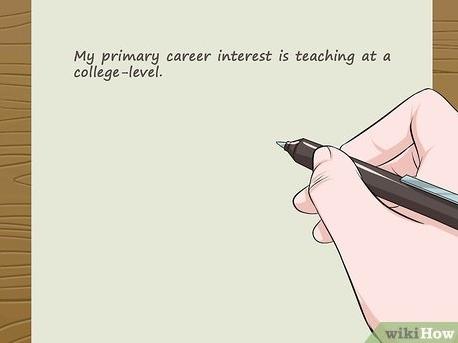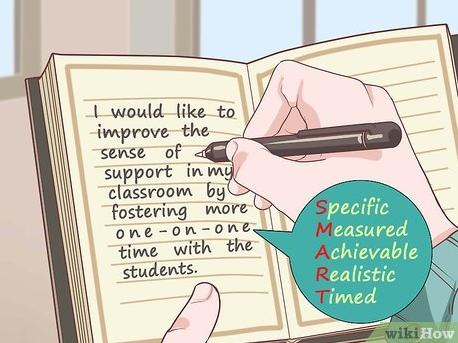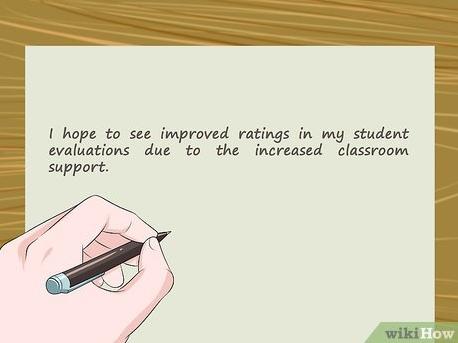Part 1 of 3:Establishing Your Overall Goals 1. Start by writing down your primary field of interest.

To write a career development plan, you'll want to start somewhat vague and narrow things down from there. To start, consider what your primary field of interest is. If you had to define your career by a few terms, how would you define it?
For example, say you want to work in an academic field. You could write something like, "My primary career interest is teaching at a college-level."
2. Consider how you identify professionally.

From here, think about how you define yourself professionally. What skills do you bring to the table in a given place of work? Also think about what drives you and what kind of worker you are.
Try to write down some of your personal skills. Even if you're just starting out, you may have general qualities that can be an asset to an employer. For example, maybe you're hardworking. Maybe you're easy to get along with and tend to be helpful to others.
Discuss your hobbies and education. These can help establish the skills you have already learned that you can bring to the work force.
What drives you as a worker? Are you driven by passion, the aspiration for success, or something else? Write down your main motivational factor before continuing with your plan.
3. Establish where you are at the moment.

You need to know where you're starting to flesh out a career development plan. Take a moment to honestly assess where you are at the present moment so you can figure out where to go from here.
What is your current position in your field? Have you just finished your education? Are you beginning your educational path towards your goal career? Are you working an entry level position?
Write down exactly where you fall on the career ladder right now. For example, "Graduate student and teaching assistant in literature."
4. Think about where you want to be in the future.

From here, figure out the career you ultimately want. In order to hash out how to get from Point A to Point B, you need a firm idea of what Point B is.
Leave aside any barriers here when you considered your dream career. If there was nothing holding you back, where would you ideally be in 5 years? 10 years? Do not worry about dreaming too big.
Write down your ultimate career goal. For example, you could write something like, "I would like to be a tenured literature professor at a four year university."
Part 2 of 3:Breaking Your Goals Down into Smaller Steps 1. Set SMART goals.

SMART is an acronym that can help you create a series of realistic goals that help you achieve success. SMART stands for smart, measurable, achievable, relevant, and time bound.
Write down a series of short and long term goals that will help you achieve your dreams. These goals should be relevant to your career at hand and obtainable. They should also be tangible goals so you can measure your progress along the way. Have a sense of when you want to achieve certain goals. For example, "Be a better teacher" is somewhat vague. To make it a SMART goal, think about what areas you want to improve in and write goals that cater to those areas.
You could narrow down the following goal more. For example, you could say something like, "I would like to improve the sense of support in my classroom by fostering more one-on-one time with the students." This is a measurable, specific goal that's relevant to your career. You can also set a time table for this goal. You can plan to foster more one-on-one time by spring semester.
2. Write down concrete means to achieve your goals.

Once you've established your SMART goals, you'll need to write some action steps. Think of how you mean to achieve these goals. In addition to focusing on how you'll achieve a goal, think about when and where you'll achieve it and the results you'll see after completing it.
Returning to fostering more one-on-one time in the classroom, think about how this could be done. It's okay to consult other teachers and mentors here for advice. Maybe you could require three conference days where you talk to students one-on-one about their progress each year. You could also try to be more available electronically. Be more vigilant about returning student emails so students feel they can come to you with concerns.
From here, figure when you want to get this done by. These could be your goals for the coming semester. You could strive to improve the level of one-on-one support by the end of spring semester. The results, which should be measurable, could be your student evaluations. Write down something like, "I hope to see improved ratings in my student evaluations due to the increased classroom support."
3. Identify any barriers to your goals.

All goals come with barriers. You want to go into your career path with a realistic sense of what could potentially hold you back. Make a list of potentially barriers that keep you from achieving the short and long term goals in your career path.
These can be personal issues. For example, you may be a disorganized person by nature. Therefore, it may be hard to keep up with things like student email and grading. You could write down something like, "Being disorganized reduces the time I have available for my tasks". Or maybe you purposefully avoid doing certain tasks that you don't enjoy, which you could list as "My tendency towards procrastination may hold me back."
There may also be larger factors at play holding you back from your dreams. For example, academia is a competitive field with a limited number of jobs. You could write something like, "The job market for academic careers in the humanities is very competitive."
4. Figure out means to defeat these barriers.

Once you've identified barriers, figure out how you want to overcome them. What can you do to make sure you'll reach your career goals despite setbacks?
If you're a procrastinator by nature, what steps can you take to combat this? You can say something like, "I will limit my time on Facebook and Twitter." If you're disorganized, you could say "I will start using a calendar to track deadlines".
As for larger barriers, like a competitive job market, what can you do to set yourself apart? In academia, connections and active participation in the community can help set you apart. You could write something like, "I will maintain positive references with my contacts from graduate school" and "I will join a variety of academic organizations relevant to my field."
Part 3 of 3:Evaluating Your Progress and Setting Deadlines 1. Figure out how to measure career progress.

Once you've established a series of goals, figure out ways to evaluate your progress. Your career development plan is a tool to keep you on track. You want to make sure you have concrete ways to assure you're where you want to be at any given time.
Know means of evaluating your success. For example, you could strive for improved ratings in student evaluations each semester.
You should also focus on participation in the community, maintaining contacts, and achieving certain awards, honors, and publications. How many publications you have, and any academic honors you receive, can be concrete measures of success. The time you've committed to an organization can also speak to success. For example, you could pledge at least a year to working on the student affairs committee in your graduate program.
2. Order your career development on a timeline.

Once you've established a series of goals, order your timeline in a logical trajectory. Start with your short term goals and move up to your longterm goals, until you've achieved your dream. You essentially want to carve out a road map you'll follow to success.
You can start at the beginning. Look at the goals you want to achieve by the end of this month or year. Write them down in order at the beginning of your timeline, including how you'll achieve these goals, any possible setback, and how you'll evaluate your success.
Then, move forward. What do you want to achieve in the next two years? The next five years? The next ten years? Keep adding on your goals in order, including setbacks, means to measure them, and means to achieve them.
For the example, your career path may start with activities in graduate school. These could include solid student teaching experience, obtaining awards and honors, and participating in graduate school organizations. As you move forward, you may want to gain an adjunct position, then move on to more permanent work. Eventually, your path should lead you to obtaining the role of a tenured professor of literature.
3. Make note of milestones.

You should mark milestones on your career path. These are important skills, certifications, awards, and so on that you receive that will help you on your career. Know what kind of milestones you're striving towards, and when you hope to achieve these milestones.
For an academic path, a milestone may be something like obtaining your master's degree, and then your doctorate. You also want to include things like accruing a particular honor or award, like gaining membership into an honors society.
4. Keep the plan dynamic.

Your career plan is not set in stone. Keep in mind your goals may change over time. You may need to tweak your career plan due to unforeseen circumstances. You also may change what you want with time, or realize the means to achieving a particular goal are different than you anticipated. Save a copy of your career plan to your computer, and keep in mind you can always alter it in the future.


No comments yet, come on and post~